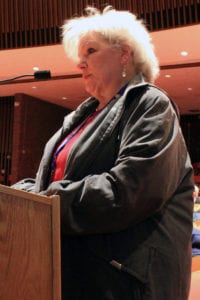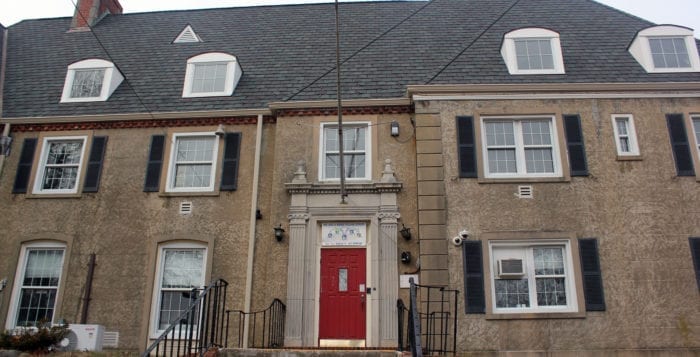By Kevin Redding
Some residents see it as a magical place full of rich history and memories that deserves preservation, others consider it a tax burden that should be sold and disposed of. The future of Briarcliff Elementary School, a shuttered, early-20th century building on Tower Hill Road in Shoreham, is currently up in the air as the school district looks to community members to weigh in on potential options.
A dozen voices were heard Jan. 9 during a public forum held by Shoreham-Wading River’s board of education to decide the fate of the beloved historic school, which has sat vacant for the last three years. The nearly 27,000-square-foot manor was built in 1907, expanded on through 2007 and closed permanently in 2014 as part of the district’s restructuring plan.

Administrators made it clear during the meeting that the board has no plans for the property at this time and, due to declining enrollment throughout the district, does not foresee it will be used for instructional use anytime soon — be it a pre-K or BOCES program. Board members said it will determine the best course of action for the building based on input from the community in the coming months.
“The board will not be making any decisions tonight on the future of the Briarcliff elementary school building, we’re only listening to residential statements,” said board president Robert Rose. “We recognize the importance of input from the entire community.”
This year, the annual operating costs for the property are estimated to total $95,000, which are expensed through the district’s general fund and includes building and equipment maintenance; insurance; and utilities, according to Glen Arcuri, assistant superintendent for finances and operations.
A presentation of the pricey upkeep didn’t dissuade several residents from speaking passionately about the school’s place in the history of Shoreham, pleading with the board to neither sell nor redevelop it for condominiums, as one speaker suggested.
“It was such a wonderful place — the children loved the building,” said Bob Korchma, who taught at Briarcliff for a number of years. “To lose such a great part of our community for housing and any other endeavors would be crazy. It has such history and working there was one of the best parts of my life.”
Debbie Lutjen, a physical education teacher at the school for 10 years, echoed the sentiments, calling the building “special,” and encouraged the board to move the two-floor North Shore Public Library that is currently attached to the high school to Briarcliff.
“If we sell, it’s a one-time influx of cash and we’re never going to get it back again. I think we should work together to keep it as an asset for Shoreham-Wading River.”
—Colette Grosso
“The majority of my teaching career in the district was at the high school, and when they put the public library there, I believe it created several security problems where the general public was on school grounds during the school day,” Lutjen said, suggesting that the freed up space at the high school could be used for classrooms, a larger cafeteria, a fitness center and testing rooms.
Residents also pushed the idea to designate the building a historic landmark and pursue grants, potentially from U.S. Rep. Lee Zeldin (R-Shirley), to restore it. David Kuck, whose son went to Briarcliff, said on top of making it a historic site, the district should turn it into a STEM center for students across Suffolk County, as it stands in the shadow of inventor Nikola Tesla’s famous Wardenclyffe Tower.
David Madigan, a Tesla Science Center board member and a former Briarcliff student, outlined the building’s history for the board — three generations of the prominent Upham family, including a veteran of the Civil War, built and owned the school in three different phases — and urged that covenants be filed on the property that says the building could never be taken down.
“The exterior must be kept in its historic state,” Madigan said. “It’s a very valuable and historical asset for our village. And it’s the most important thing to preserve as a resident.”
Joan Jacobs, a Shoreham resident for 40 years and former teacher, explained to the board how the building was the model for the mansion in the “Madeline” children’s books by Ludwig Bemelmans, who worked at a tavern on Woodville Road.

“It’s so rich and having taught there for 14 years, having a daughter go through there, there’s an awful lot there,” an emotional Jacobs said. “It’s a shame to throw away our history.”
Both Bob Sweet and Barbara Cohen, members of Shoreham Village, advocated that the school be redeveloped as a residence for seniors in the area.
“I care about this building and sorely miss when the school buses coming up the road to drop the grade schoolers off,” Sweet said. “I admonish you don’t sell the property and explore the notion of turning this into condos for retired village members.”
But Colette Grosso, a special education aide at Miller Avenue School, said she hopes the community works toward a solution where the building remains an asset within the district for educational purposes as opposed to housing.
“All-day daycare and aftercare services could be done there, and there are other organizations besides BOCES that would love to use the facility to serve special education, which is an underserved population,” Grosso said. “If we sell, it’s a one-time influx of cash and we’re never going to get it back again. I think we should work together to keep it as an asset for Shoreham-Wading River.”
Further discussions with community members on Briarcliff will occur at the next board of education meeting Feb. 13 in the high school auditorium at 7 p.m.






